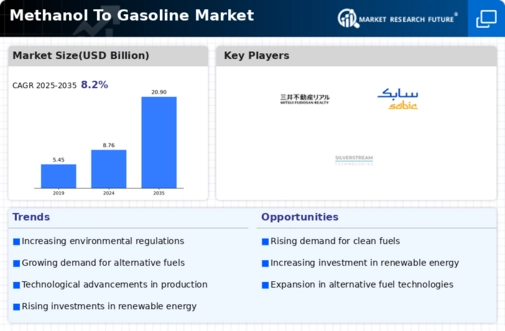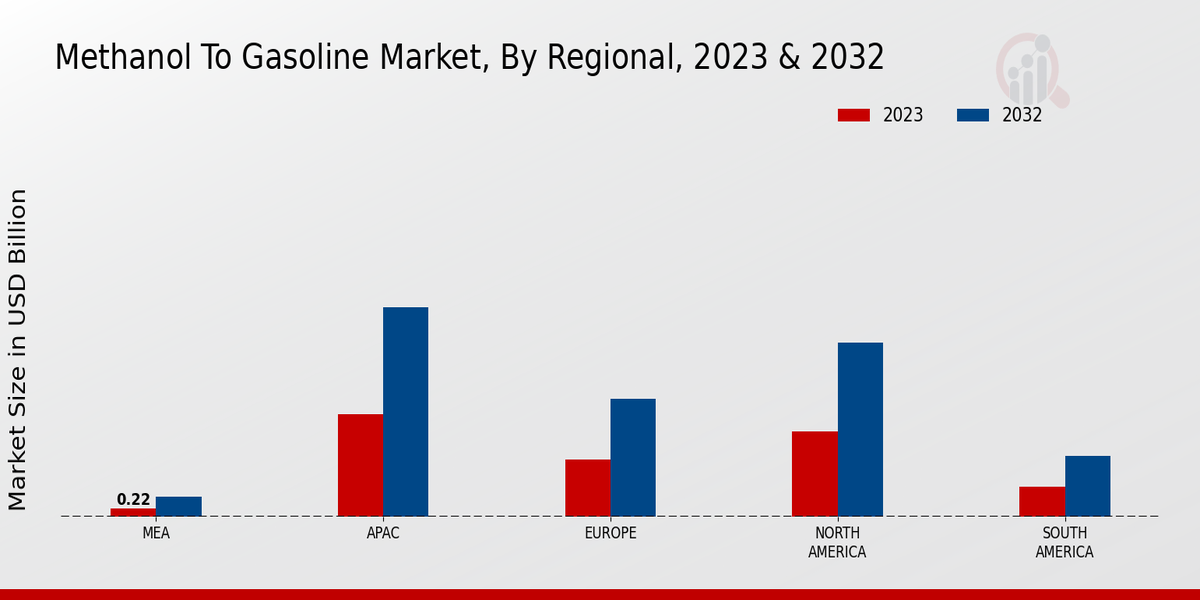Market Trends and Projections
The Global Methanol To Gasoline Market Industry is poised for substantial growth, with projections indicating a market size of 20.9 USD Billion by 2035. This growth is underpinned by a compound annual growth rate (CAGR) of 8.21% from 2025 to 2035, reflecting the increasing adoption of methanol as a viable fuel alternative. Key trends influencing this trajectory include advancements in production technologies, supportive government policies, and a growing emphasis on sustainability. As the industry evolves, stakeholders are likely to focus on enhancing production efficiency and expanding application areas, ensuring that methanol remains a competitive player in the global energy landscape.
Rising Demand for Clean Fuels
The Global Methanol To Gasoline Market Industry is witnessing a surge in demand for cleaner fuel alternatives. As countries strive to reduce greenhouse gas emissions and combat climate change, methanol, derived from renewable sources, presents a viable solution. This shift is evident in regions like Europe and North America, where stringent environmental regulations are being implemented. The industry's growth is projected to reach 8.76 USD Billion in 2024, driven by increasing investments in methanol production facilities and advancements in conversion technologies. Governments are incentivizing the adoption of methanol as a fuel, further propelling market expansion.
Government Policies and Incentives
Government policies and incentives are crucial drivers of the Global Methanol To Gasoline Market Industry. Many nations are implementing supportive frameworks to promote the use of methanol as a transportation fuel. These policies often include tax breaks, subsidies, and research grants aimed at fostering innovation in methanol production and utilization. For example, countries like China and the United States have introduced initiatives to encourage the development of methanol-based fuels. Such measures not only stimulate market growth but also align with global sustainability goals, thereby enhancing the attractiveness of methanol as a clean fuel alternative.
Market Diversification and Applications
The Global Methanol To Gasoline Market Industry is characterized by its diversification and wide range of applications. Methanol is not only utilized as a fuel but also serves as a feedstock for various chemical processes, including the production of formaldehyde and acetic acid. This versatility enhances the market's resilience and attractiveness to investors. Furthermore, the growing adoption of methanol in the automotive sector, particularly in flexible fuel vehicles, is expanding its market reach. As industries seek to reduce reliance on traditional fossil fuels, methanol's multifaceted applications are likely to drive sustained growth in the coming years.
Increasing Investment in Renewable Energy
The Global Methanol To Gasoline Market Industry is benefiting from a growing trend of investment in renewable energy sources. As the world transitions towards sustainable energy systems, methanol production from biomass and other renewable feedstocks is gaining traction. This shift is supported by various stakeholders, including governments and private investors, who recognize the potential of methanol as a renewable fuel. The industry's expansion is likely to be bolstered by a compound annual growth rate (CAGR) of 8.21% from 2025 to 2035, reflecting the increasing focus on renewable energy solutions and the need for cleaner fuel alternatives.
Technological Advancements in Conversion Processes
Technological innovation plays a pivotal role in the Global Methanol To Gasoline Market Industry. Recent advancements in catalytic processes and reactor designs have enhanced the efficiency of methanol conversion to gasoline. These innovations not only improve yield but also reduce operational costs, making methanol a more attractive option for fuel production. For instance, the development of new catalysts has been shown to increase conversion rates significantly. As these technologies continue to evolve, they are expected to support the industry's growth trajectory, potentially leading to a market valuation of 20.9 USD Billion by 2035.





